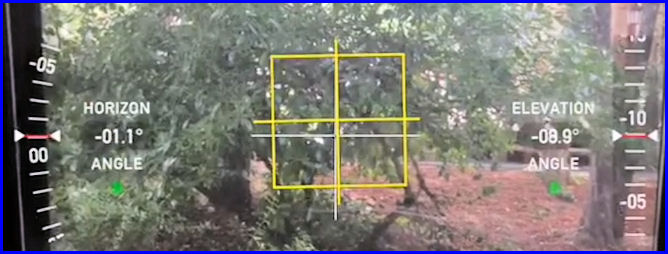Theodolite is a multi-functional app that combines a compass, inclinometer, rangefinder, GPS, map, and camera with geo-overlay for augmented reality. It's essentially a digital theodolite, allowing users to measure angles, distances, and positions using their smartphone or tablet. This is the perfect way to locate the moon in azimuth and elevation for pointing the antenna. I purchased this app from the Apple Store for $9.53 and in my opinion it is well worth that price.
Below is my first attempt at using this app to locate the moon. Local time was just after midnight and Full Moon is in 2 days so this moon was over 90% illuminated - it is bright! You can see a tree to the left of the moon and also a portion of the edge of my garage. This image was taken at the point where I plan to set up my Sub-Lunar Folding Dish. At the time I took this photo the declination was -27° so the moon was not very high in the sky even though it was nearly due South of me. You can see that the Horizon Angle on the left shows the phone was tilted 2.7° away from horizontal. (Click on any image to see a larger version.)
I placed inside the Theodolite image a Yellow bordered box showing the Astronomical Data from WSJT-X for the same date/time. You can see the app shows an Azimuth of 187° and WSJT-X shows 187.5° and since the moon is actually below the crosshairs, the indicated Elevation Angle on the right (of +25.3°) was a little off from the WSJT-X number of 23.7° At the top of the screen the app also shows my latitude/longitude and elevation.
I learned that I might want to set my iPhone on a tripod to keep it steady in the future. Just holding the phone in my hands it was difficult to center the moon in the app. Also, you can push the "Zero" button in the bottom left and it will put a box around the crosshairs in the center of the image. This box changes color from Red to Yellow to Green then White as you get the image lined up with the horizon so the elevation numbers are correct. What this button does is to zero all angles at a given orientation of the device, thereby showing angles relative to that reference until you tap the button again. Once you tap zero again the true angles will be displayed and if the phone has not moved, the Elevation Angle will be correct (as long as the moon is centered in the crosshairs!)
In the example below the Elevation Angle on the right shows -08.9° but the Horizon Angle on the left shows the image is -01.1° from being level. And, the yellow box shows you are close to being lined up. If you line up the image and "then" press the Zero button, it will adapt the image so that the Horizon angle is 0.0°
I don't think this app will take much effort to be able to dial in the location of the moon. Once I have those numbers, I can set up my SL-1 Az-El Positioner to the current moon location and "hopefully" it will then track the moon automatically. If I don't have visible moon, I "think" I can still use this app to align it with the dish feed and use that as the starting position for the Az-El Positioner. The Theodolite User Manual is located HERE.




